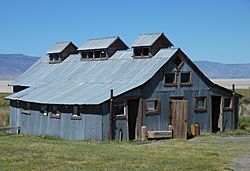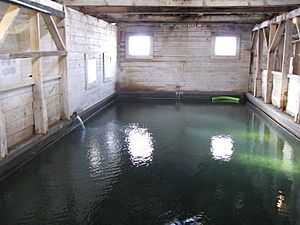Summer Lake Hot Springs facts for kids
Quick facts for kids Summer Lake Hot Springs |
|
|---|---|

Hot springs bathhouse built in 1928
|
|
| Location | Lake County, Oregon |
| Coordinates | 42°43′30″N 120°38′49″W / 42.72500°N 120.64694°W |
| Elevation | 4,268 feet (1,301 m) |
| Type | Natural hot spring |
| Temperature | 124 °F (51 °C) |
The Summer Lake Hot Springs are amazing natural hot springs found at the southern end of Summer Lake in south-central Oregon. These springs are like natural fountains, pushing warm, mineral-rich water up from deep underground. There are four different spots where the water comes out of the ground. The main spring is usually around 123 °F (51 °C) and flows out at about 20 US gallons (76 L) every minute. Over many years, this spot has become a fun and relaxing place for families to visit and bathe. The hot springs are about 124 miles (200 km) southeast of Bend, Oregon, close to the small town of Paisley, Oregon.
Contents
Discover Summer Lake Hot Springs
Summer Lake Hot Springs are special because they are "artesian" springs. This means the water is pushed up naturally from deep underground without needing a pump. This water is heated by the Earth's warmth and contains many different minerals.
What Makes These Springs Hot?
Scientists believe these hot springs are formed because of cracks, called faults, in the Earth's crust. The springs are located at the bottom of a mountain with a steep rock face. Below the springs, there are layers of lake sediment on top of hard basalt rock. This unique geology allows the hot water to rise to the surface.
Over the years, people have measured the temperature and flow of the springs many times. The main spring's water is usually around 123 °F (51 °C) to 124 °F (51 °C). When the water reaches the main pool in the bathhouse, it's about 113 °F (45 °C). The other three hot springs have water temperatures between 106 °F (41 °C) and 118 °F (48 °C).
Water's Special Ingredients
The water in these springs has a lot of different minerals mixed in. It's like a natural mineral drink! Some of the main minerals include sodium (like in salt), potassium, chloride, sulfur, and silica. You can also find smaller amounts of boron, fluorine, calcium, and magnesium. There are even tiny traces of lithium, hydrogen carbonate, iron, and aluminum. These minerals are what make the hot springs water feel unique.
Nature Around the Springs
The weather in the Summer Lake Valley, where the hot springs are, is a bit milder than other parts of Oregon's high desert. This is because Winter Ridge, a large mountain, protects the valley from the west.
The temperature here averages 80 °F (27 °C) to 90 °F (32 °C) in the summer. In winter, it's colder, usually 20 °F (−7 °C) to 30 °F (−1 °C). It can get very hot, up to 105 °F (41 °C), and very cold, down to −25 °F (−32 °C). The area gets about 12 inches (30 cm) of rain each year.
The ground around Summer Lake is mostly made of sand and silt from an old lakebed. Winds often blow sand and soil across the dry lakebed, forming small dunes near the lake's edge.
Plants and Animals You Might See
The plants in this area are mostly desert shrubs. You'll see lots of big sagebrush, green rabbitbrush, and black greasewood.
Many animals live near the hot springs. Larger animals include mule deer, coyotes, bobcats, and cougars. You might also spot American badgers, different types of jackrabbits, and Mountain cottontails. Smaller animals like Belding's ground squirrels, chipmunks, and Ord's kangaroo rats are common too.
The Summer Lake Valley is a fantastic place for birdwatching because over 250 different bird species have been seen here! Summer Lake is an important stop on the Pacific flyway, which is like a highway for migrating birds. Many waterfowl like Canada geese, snow geese, swans, and various ducks stop here twice a year. You can also see shore birds like American avocets, snowy plovers, and sandhill cranes. Birds of prey, such as great horned owls and golden eagles, also live in the area.
A Look Back in Time: History
Native Americans lived around Summer Lake Hot Springs for at least 14,000 years. Proof of their presence has been found in the nearby Paisley Caves. To these early people, the hot springs were known as Medicine Springs.
In 1843, Captain John C. Fremont explored this area and named the large, salty lake to the north "Summer Lake." The hot springs later got their name from this lake.
From Ancient Times to Today's Resort
Early pioneers who settled in the Summer Lake area called the springs Woodward Hot Springs. This was after the Woodward family, who arrived in 1902 and were among the first to build a home there. They used the springs to water their gardens and for bathing.
The main bathhouse at Summer Lake Hot Springs was built in 1928. It's a simple building made of wood and covered with corrugated tin. Inside, there's a 15-by-30-foot (4.6 m × 9.1 m) pool for bathing, plus changing rooms.
Many ancient Native American tools and artifacts, like arrowheads, have been found at the hot springs site. Scientists have also found fossil bones of ancient horses and camels that lived during the Pleistocene Ice Age. In 1959, a large collection of artifacts was found, including a special grinding stone with three legs. This discovery happened when the springs were being developed into a resort.
Even though people had used the springs for bathing for a long time, it wasn't until 1959 that it became a commercial resort. Jeff McDaniel bought the property and started adding cottages and a barn. He also made spots for travel trailers and RVs. His family ran the resort until 1997, when Duane Graham bought it.
Today, the resort has the original bathhouse and two outdoor hot pools. You can stay overnight in rental cottages, studio cabins, or bring your RV or tent. There are also picnic tables, fire pits, and nature trails to explore. The resort has hosted many fun events like music festivals, and workshops on astronomy, yoga, and photography.
How to Visit Summer Lake Hot Springs
The Summer Lake Hot Springs are easy to find, just off Oregon Route 31. They are about 6 miles (9.7 km) northwest of Paisley, Oregon. Oregon Route 31 is part of the Outback Scenic Byway, which is a special scenic road. The closest big city is Bend, Oregon, which is about 124 miles (200 km) northwest of the hot springs.



